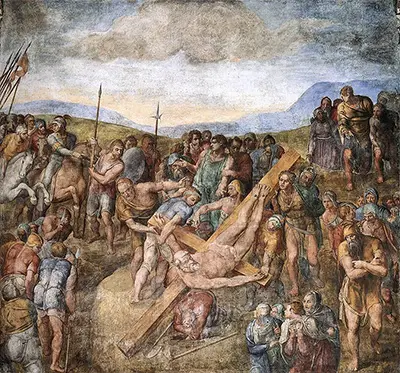It is found in the Cappella Paolina in the Vatican Palace along with another of Michelangelo’s frescos, “The Conversion of St Saul”. Tourists cannot enter the Cappella as it is a sacred space; this fresco remains a somewhat obscure work.
The Martyrdom (Crucifixion) of St Peter has attracted criticism that the figures are disproportionate. It has been argued that Michelangelo has done this purposefully. He painted the figures in such a way that the viewer on the ground would see the figures in proper proportions as they look up.
This is a technique that Michelangelo used previously, notably on the statue of Moses which adorns Pope Julius II tomb.
Peter is the subject of many of the works in the Vatican because of his position within the church. He was the first Pope, and the ”rock” upon which the church is built. The fresco shows the moments before St Peter is crucified, head downward.
It depicts the raising upright of the cross which Peter is already painfully nailed to through his hands and feet. Peter himself is not shown by Michelangelo in the typical renaissance martyrs pose.
There is no serene heavenward gaze. Instead Peter looks directly at the viewer, in a last show of strength his body is contorted into this position. His expression is that of confidence in his triumph over his suffering.
Groups of people surround Peter's central position in the work which gives the painting a chaotic atmosphere. It is a lively scene, full of bustle and movement. There is a man hurriedly finishing the post hole so that the cross can be set upright and Peter’s execution can begin. There are frightened women in the foreground.
Their faces show their horror and distress at what Peter is about to experience. On the left, there are figures walking up the stairs toward the horse mounted men. Michelangelo has included himself in the scene; he is the horse rider with the blue turban in the upper left of the fresco.
He was discovered when the painting underwent restoration. Behind Peter in the centre there is a group of men conversing. One of them is being hushed perhaps in case the elderly apostle overhears what is said. The background mountains in the painting have no detail defined.
The mountains are painted using a mist like blue to give the impression both of distance and depth of field. Caravaggio was inspired by elements of Michelangelo’s work for his own Martyrdom of St Peter. The movement here can also remind us of the French Romanticists such as Eugene Delacroix and Theodore Gericault.


